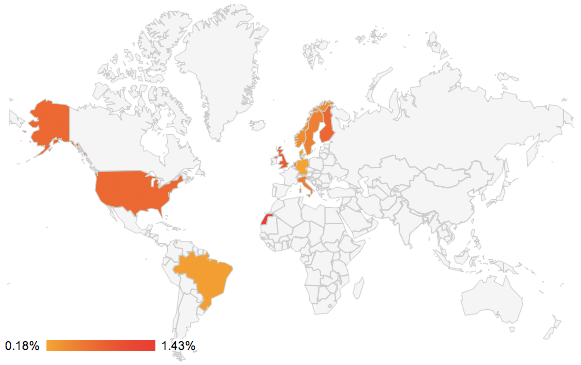What Is Celiac Disease?

Find out if you are at risk - get tested
| TEST | TESTING TIME | PRICE |
|---|---|---|
| DNA Celiac Disease Test | 4 to 6 weeks | $249 USD |
Celiac Disease is a systemic autoimmune disease caused by an immune-mediated response to gluten leading to inflammation of the small bowel. The inflammation damages the villi lining the small intestine and interferes with food absorption. If Celiac Disease is left untreated or is unresponsive to treatment, patients may have increased mortality due to an increased rate of malignancies. Affected individuals that adhere to a strict gluten-free diet show no difference in mortality rate compared to a control unaffected group.
Although Celiac Disease has been recognized for the past 2,000 years, it was only in the 1950s that wheat was identified as the critical environmental factor contributing to the disease.
What Causes Celiac Disease?
Celiac Disease has a strong genetic association with mutations in the genes of the human leukocyte antigen system (HLA), a major histocombatibility complex. These genes code for glycoproteins that bind to peptides to form an HLA-antigen complex that can be recognized by CD4+ T cell receptors in the intestinal mucosa. This complex plays an important role in the immune system through presentation of peptides from extracellular proteins.
After a person consumes a meal, the nutrients in the food are absorbed by small projections called “villi” on the surface of the small intestine. Genetic mutations in the HLA genes associated with Celiac Disease cause the complete or partial formation of HLA-DQ2 and/or HLA-DQ8 heterodimers. Undigested deaminated dietary gluten peptides bind to the HLA-DQ2 or HLA-DQ8 receptors on antigen-presenting cells and are presented to CD4+ T cells, causing an immune response to dietary gluten. This immune response to dietary gluten causes inflammation and damage to the intestinal tissue and villi and results in Celiac Disease.
Other Factors Associated with Celiac Disease
Although Celiac Disease has a strong underlying genetic basis (almost all individuals who have Celiac Disease will test positive for Celiac Disease-associated alleles), not all people with Celiac Disease-associated alleles will eventually develop Celiac Disease. Traumatic events including surgery, pregnancy, childbirth, viral infections or severe emotional stress may trigger the disease in genetically susceptible individuals. A number of other non-HLA candidate susceptibility genes have been identified, but further research is required to confirm their link to Celiac Disease. Dietary gluten is the crucial environmental factor that triggers development of Celiac Disease in genetically susceptible individuals.
Genetics of Celiac Disease
The HLA protein underlying Celiac Disease is a heterodimer composed of two chains: HLA-DQA1 and HLA-DQB1. Mutations in HLA-DQA1 (HLA-DQA1*05) in combination with mutations in HLA-DQB1 (HLA-DQB1*02) form the DQ2 heterodimer which is found in 90-95% of patients with Celiac Disease. Another mutation in HLA-DQB1 (HLA-DQB1*0302) causes the formation of the HLA-DQ8 heterodimer which is found in 5-10% of Celiac Disease cases.
Summary of the Genetics of Celiac Disease
Celiac Disease is associated with Celiac Disease-associated HLA alleles: HLA-DQA1*05, HLA-DQB1*02, and HLA-DQB1*03. The majority of individuals who have Celiac Disease are positive for one or more of the Celiac Disease-associated HLA alleles.
The presence of celiac disease-associated HLA alleles implies an increased risk for celiac disease, but is not diagnostic of celiac disease as only a subset of individuals with these alleles will develop celiac disease. However, individuals who test negative for the celiac disease-associated alleles HLA-DQA1*05, HLA-DQB1*02 and HLA-DQB1*0302 can essentially exclude a diagnosis of celiac disease and have almost no lifetime risk of developing celiac disease (less than 0.04% chance), regardless of whether or not they ingest gluten.
How Common is Celiac Disease?
Celiac Disease is most common in Caucasians and people of European descent; the disease occurs throughout Europe, the United States, Australia, Mexico, and some South American countries. In the United States, the prevalence is 1 in 100 to 150 people.
The prevalence of Celiac Disease in children 2.5 to 15 years old in Europe and the United States is approximately 1 in 80 to 300 (3 to 13 children per 1,000). Women seem to have a higher incidence of Celiac Disease then men.
Celiac Disease is becoming one of the most common disorders that affects about 1% of people worldwide, and the impacts of Celiac Disease in developing countries requires further evaluation. For example, in the Saharawis, it is estimated that 1 in 18 children are affected with Celiac Disease.

| Geographic Area | Prevalence based on Clinical Diagnosis | Prevalence based on Genetic Screening |
|---|---|---|
| Brasil | N/A | 1:400 |
| Denmark | 1:10,000 | 1:500 |
| Finland | 1:1,000 | 1:130 |
| Germany | 1:2,300 | 1:500 |
| Italy | 1:1,000 | 1:184 |
| Netherlands | 1:4,500 | 1:198 |
| Norway | 1:675 | 1:250 |
| West Sahara | N/A | 1:70 |
| Slovenia | N/A | 1:550 |
| Sweden | 1:330 | 1:190 |
| United Kingdom | 1:300 | 1:112 |
| United States | 1:10,000 | 1:133 |
| Worldwide (average) | 1:3,345 | 1:266 |
Increased Risk with Associated Diseases
There are several conditions that may increase the likelihood of developing Celiac Disease. The disease tends to occur more frequently in individuals with:
- Autoimmune disorders (rheumatoid arthritis, systemic lupus erythematosus, Sjogren syndrome)
- Addison’s disease
- Down syndrome
- Intestinal cancer
- Intestinal lymphoma
- Lactose intolerance
- Thyroid disease
- Type 1 diabetes


